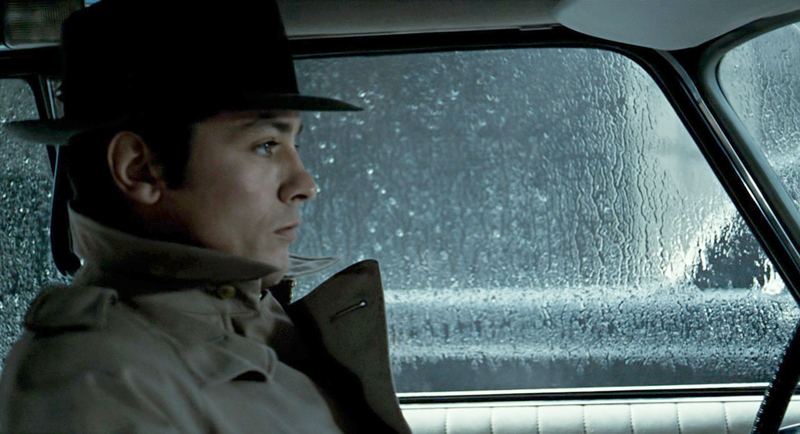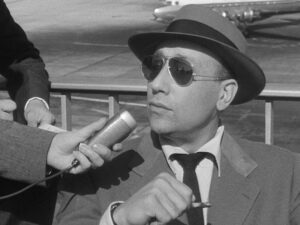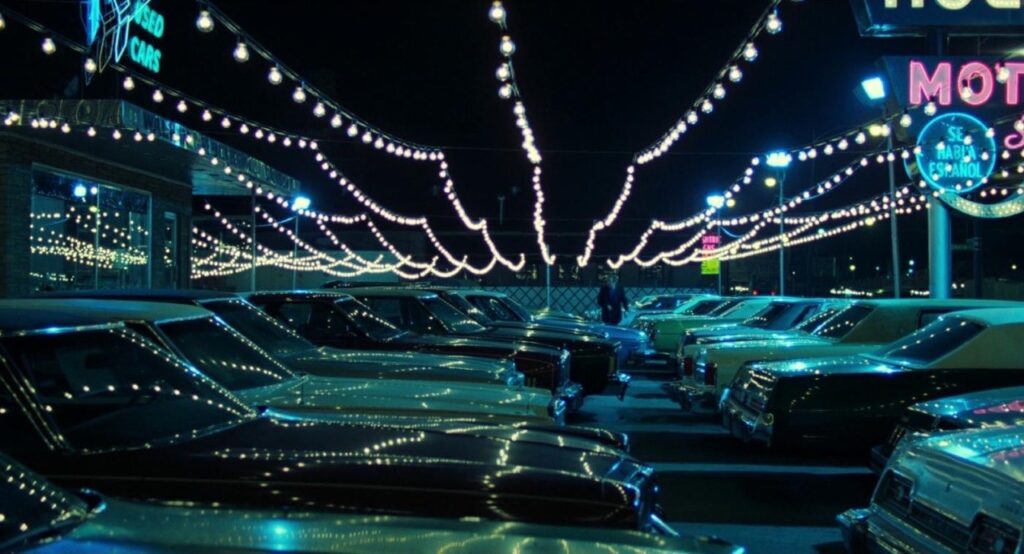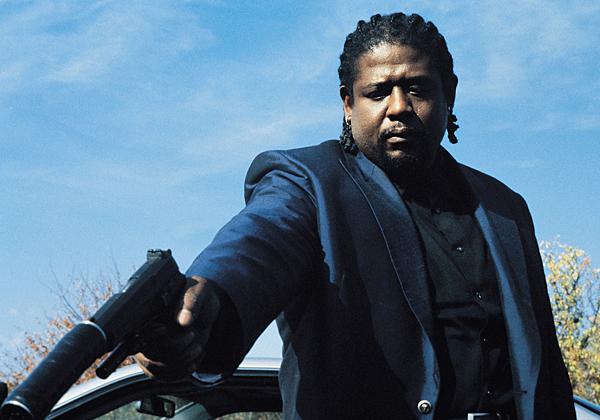
You know the vibe even if you don’t know the source. Electric streetlights, endless concrete, desperate people living among and outside the normal population, smoky nightclubs, repression of emotion, fetishization of the automobile, and the friction of modernity versus tradition. Diagetic music, suggesting that our characters themselves are cool enough that they would also be watching this movie. And most of all, how hard it is to maintain a rigid moral code in a modern world where nothing is sacred.
This is so commonplace that it is weird to think there was a time when it wasn’t part of the language of cinema. I’m not a movie historian, so I won’t go down every rabbit hole. “Fritz Lang’s M (1931) is the birth of urban noir” and “give me The Maltese Falcon (1941) and Little Caesar (1931) or get out of here” are defendable positions. Further, Point Blank (1967) and Bullitt (1968) and Bonnie and Clyde (1967) and Blow Up (1966) either rode on the New Wave’s coattails or had a convergent evolution (let the historians sort it out). However, I’m not here to talk about those. I’m interested in where those nighttime/gangster influences merged with an idea of cool and were used to make sense of life in a neon world where technology has upended everything.
We’re talkin’ Melville, baybee!

Background
Jean-Pierre Melville was a French filmmaker whose work predated and helped usher in the eternal cool of the French New Wave (see him above in Godard’s Breathless (1960)–Ed.). He died far too young in 1973, at the age of 55, That is perhaps longer than he may have expected to live, having served in the French Resistance to Nazi occupation during World War II. With a million years of hindsight, it is easy to read into his films the processing of the war’s trauma (artistically, personally, culturally, nationally) just like how our country behaved after September 11, 2001 or for two decades after the loss of the Vietnam War. Postwar France and its accompanying modernization were sources of horror for another favorite filmmaker of mine, Jacques Tati, whose Monsieur Hulot is a man out of time in electric Paris. In Melville’s films, this collision of old and new, of ruins and shining steel, provides an iconic backdrop for stories of the desperate and the new social dynamic in which women vote and have slightly more control over their lives. That so many of Melville’s films became icons of the heist genre makes absolute sense. Look at the lifelong losers in Le cercle rouge (1970) seeking a means to make up for time lost in prison, or Bob le flambeur (1956) being a local criminal fixture for so long that even the cops just smile and nod.
Nowhere is Melville’s ethos more apparent than in his greatest film, Le samouraï (1967), about a laconic hitman whose regimented life is upended not because he got sloppy in his work, but because those who pay him to commit crimes value their short-term profits over the long-term value of employing such a professional.
There are obvious forebears to Melville’s work, including gangster pictures like Little Caesar and White Heat (1949), and even the French-by-way-of-blacklisted-American heist film Rififi (1955). Samurai stories are an obvious influence as well (and Melville’s syncretism of gangsters, ronin, and the individual in a modern world become a staple of Japanese action cinema (see Seijun Suzuki’s Tokyo Drifter (1966) or the electric guitar and bloodspray madness of the Lone Wolf and Cub series)), and the failings of a rigid moral code can be traced to old French stories like King Arthur’s kingdom falling to ruin as he wastes his legendary knights chasing the most famous McGuffin in Christian history.
But that feeling of a blade of grass pushing through a sea of concrete, of life living even under suboptimal conditions, and the inevitability of betrayal… nothing does it better than Le samouraï .
Which explains why so many of my favorite filmmakers have used the iconography to tackle their own theses.

Descendents
The Conversation (1974)
Gene Hackman’s Harry Caul is a perfect example of the the professional with the rigid code becoming chewed up and spit out by the modern world. Caul is an uptight professional eavesdropper, a devoutly religious man and a bundle of repressed behavior. His only two emotional outlets appear to be playing jazz saxophone and failing at a romantic relationship (here are a couple of pro tips, Harry: don’t stand outside her apartment and watch her, don’t tap her phone, take your shoes off in bed). He certainly takes no joy in hearing the private conversations of other people.
I mentioned it on my Instagram, but this movie is heroin for people who love analog technology of any kind. Harry’s tools in this film are hidden microphones, reels of recording tape, and a myriad of fascinating filters and gadgets that can enhance, filter, blur, and who knows what else.
Where the film feels its most Melville is when Harry takes a job that he immediately regrets once he hears what is in the titular conversation. Concerned that his work will be used to cause a crime, he tries to keep the tapes rather than hand them over to the absentee figure at the top of the skyscraper. His decision to withhold the tapes causes his life to unravel (personally and professionally) and his entire philosophy is revealed to be a coping mechanism for a past mistake.
Francis Ford Coppola gives lots of really cool shots of San Francisco (although not as good as in Bullitt), and most of the scenes take place in cramped vans and Harry’s office, a shell of an office building.
The Driver (1978)
To me, this is the first notable example of a filmmaker channeling Melville. The titular character (actually credited as The Driver) sits in a spartan apartment, waiting for the time to do his job. The time arrives, he dresses and leaves, heading through the nighttime streets of Los Angeles. His job is to be a getaway driver. He doesn’t steal, he doesn’t shoot people, he drives and does it well. And he is contracted to drive for some thieves who knock over an illegal gambling house. Something goes wrong and he is seen (by Isabelle Adjani’s The Player). His rigid code and blank stare belie his fierceness behind the wheel, but The Driver’s anger surfaces when he feels that the cowboy behavior of those who contracted him have compromised his way of life.
The rest of the film is a slow tightening of the net by The Detective (Bruce Dern) and The Driver trying to maintain control at a time when even the police give zero shits about the law. The film features several dazzling car chases through downtown LA at night.
Walter Hill goes on to create two of the most influential films in US history, The Warriors (1979) and 48 Hours (1982), essentially creating the construction of the modern action videogame and the buddy-cop film genre within a span of 3 years. Good run!
Thief (1981)
Like many movie fans of a certain age, Michael Mann basically defines the action genre for me. He shepherded Miami Vice (1984-1989) onto our televisions, introduced us to Hannibal Lecter with Manhunter (1986) five years before The SIlence of the Lambs (1991), perfected the crime genre with Heat (1995), made my favorite old-timey shoot ’em up with The Last of the Mohicans (1992), and shot a boilerplate corporate thriller with action cinema compositions, creating the masterpiece The Insider (1999). His first feature film, though, seems his most personal. Thief tells the story of a Chicago thief (the brilliant James Caan) who lost more than a decade of his life to jail (a $20 theft begat a manslaughter upcharge while in prison) and is desperate to catch up on the time he lost.
A slavish devotion to personal philosophy is a core tenet of Mann films, as is obsession with the tools of a professional trade (here, witness the iconic cracking of a massive vault). So we see some of Melville in this movie. But the thief Frank is all emotion, not repression as is Jef Costello. Where Mann veers away from Melville is in creating these interpersonal relationships and seeing how they compromise a man’s code. Frank’s need to have a family and a nice house mean working for a corrupt gangster, and that leverage slowly squeezes away Frank’s dreams. Thief is so interesting because it uses Melville’s aesthetics (dig that opening shot) to highlight the plight of the working class in a capitalist system where everyone of means is out to chisel you, where middlemen have an endless appetite for the exploitation of labor.
But my favorite way that Mann modernizes Melville is in committing to a new music. Rather than use contemporary Chicago blues rock like he had planned, or perhaps bebop like Melville’s films, Thief’s score is a synth-heavy, future-looking composition by Tangerine Dream.
The Killer (1989)
Here we see another specific homage to Melville. The titular killer of John Woo’s opus is literally named Jef, y’all.
This rigidly compartmentalized life is upended when Jef the killer, contracted to kill a gangster, accidentally blinds a singer in the gunfight. His remorse over this collateral damage causes him to take on a dangerous contract to pay for her surgery, and he soon finds his way into her life. Now the bad guys have leverage and the cops have leads, causing Jef to scramble before he is caught in a trap.
Woo’s stylized violence is well-known to action fans (in films including Face/Off (1997), Hard Target (1993), Mission Impossible 2 (2000), and Broken Arrow (1996)), but I find frustrating the limited streaming availability of his pre-US days. A Better Tomorrow (1986) and The Killer are full of melodrama and hard to find. The heightened emotions of so many supporting characters give great contrast to Chow Yun-Fat’s repressed emotions, and Hong Kong is among the most iconic cityscapes on the planet.
If you can find a blu ray of this film, buy it. I sure did!
Ronin (1998)
Ronin gets an honorary mention from me, as it tangentially fits within the legacy discussed here, and is one of the great European crime films. The interplay between so many criminals with so many different motivations is more akin to Melville’s Le Cercle Rouge, but I love the audacity of filming these mega-cool car chases through tiny streets in Paris and Nice.
Frankenheimer pioneered car chase composition with his work on Grand Prix (1966), and you can see his influence on later films, especially The Driver and Bullitt. Ronin differs from Le samouraï by showcasing an entire industry of cold war profiteering shifting into a new industry: gun-running for political extremists. So rather than working-class stiffs out for a quick score so they can get out of Paris for good, we see enemies brought teogether in the name of blood money: ex-KGB, ex-CIA, ex-IRA, ex-military, ex-everything. And while their violence plays out on the same streets where people travel to work and buy their groceries, it feels like none of them have a code… they are the next generation of criminals after the Franks and the Jefs of the world. The criminals in Ronin never had an opportunity to develop rigid morality because they were wiretapping Jean Seberg rather than watching her movies.
This sidestep is of a piece with the rest of these even if not directly related.
Ghost Dog: The Way of the Samurai (1999)
This film is maybe the most direct adaptation of Le samouraï. I find it both charming and frustrating. Jim Jarmusch has a reputation as an effortlessly cool filmmaker, and Ghost Dog has buckets of cool. There is a score by The RZA, beautiful photography by cinematography god Robby Müller, a repurposing of Melville’s tale onto slovenly New York gangsters, and a knockout performance by Forest Whitaker as the disciplined professional.
I hesitate to use the word, but the movie is just a little too cute, a little too twee. Ghost Dog follows the Bushido code of samurai and considers craven gangster Louie to be his master (Louie saved Ghost Dog from likely death in a hate crime decades before), but despite seeming to speak to no one except for Raymond the ice cream man (a brilliant Isaac de Bankolé), everyone in the neighborhood knows Ghost Dog. His local notoriety is at odds with his hermetic home life as his only vices appear to be ice cream and really good hiphop. The central portion of the movie is the shitty gangsters murdering innocent people as they futilely search for Ghost Dog, yet when Ghost Dog walks around, everyone greets him by name. How hard could it be to find him? This is a nitpick, I know, but it did take me out of the film the last time that I watched it.
The most important element of Melville’s story is the ending, which I’ve not called out yet but basically identical in Ghost Dog, and is present in Thief, The Killer, The Driver, and the other films on this list. Even above the thematic influence, the story’s ending is what links these films.
I recommend Ghost Dog, but I wish it was either a little longer (perhaps even a danged car chase?) or a little shorter (I really don’t need the gutshot gangster murdering a cop, as it does not further the plot nor support the film’s themes).
My favorite Jarmusch films are also reflections on modern city-life (Down by Law (1986), Coffee and Cigarettes (2003), and Only Lovers Left Alive (2013)) but are freer to be shaggy and loose in ways that this story cannot be.
Drive (2011)
Drive is a fulcrum point within this series of films, as it seems more indebted to The Driver (perhaps the lead character also being called The Driver was a clue) than it owes to Melville’s doomed hitman. But all of the bits are here: tight discipline, repressed emotion, strict professional code with accompanying reputation, neon streets, inevitable betrayal over petty bullshit, great car stuff, and a bit of emotional vulnerability leading to a downfall.
Drive also leans heavily into the music of its time (in this case synth-heavy electronic), which results in it feeling even more like Michaell Mann’s work. Drive also boasts brilliant lighting and most importantly, a killer star performance by Ryan Gosling and electric chemistry with his costar Carey Mulligan.
The Driver, during the day, is a stuntman for the movies, another way that this movie tethers itself to its Los Angeles filming locations. My favorite connective tissue among all of these films is the use of actual location shooting, which provides different textures and identifiable backdrops for the stories. Anyway, after dark, the Driver is a getaway driver with a very specific ethos and an eternally iconic jacket. He does a job to help out the recently paroled husband of his neighbor, and is sold out by a venal goon over a paltry amount of money. You can imagine where it goes from there, and you can rest assured that it gets there in a very stylish way.
So… is there a future installment in this legacy? We start to see people making homage to movies that were themselves homage. I feel like I’m starting to lose the thread.

Copy-of-a-Copy-of-a-Copy OR: Life Goes On
There are generational issues involved. Time moves in one direction. My cinematic idols like Michael Mann, John Carpenter, and Hal Hartley are all able to draw Social Security. Their idols–Jean-Pierre Melville, Howard Hawks, Jean-Luc Godard–are long dead or into the stage of career where their influential works were half-a-century in the past (I was quite shocked to learn that Godard was still alive. Keep on truckin’, JLG! –Ed.).
As one lives for decades and more, the influential artists of one’s early life stop making art and are replaced by new artists influenced by those older ones. At its most cynical, this is a depressing thought on the future of cinema. I shudder to think of where genre films will go when made by people raised on the sexless, bloodless, weightless, emotionally detached PG-13 goop of superhero, Star Wars, and videogames. But more germane and less cynical is that artists will always exist, drawing from a myriad of influences. We may lack the context to appreciate from where they get inspiration because they were children long after we were adults, but they will still have their own things to say about the world. Steven Soderbergh, Wes Anderson, and Quentin Tarantino are titans of pastiche from my time, and there will be future artists who do the same, even ones influenced by those three.
So while Mister Wolf in Pulp Fiction (1994) or the entire aesthetic of Reservoir Dogs (1992) may be deliberate homage to Melville, a younger filmmaker will look to Tarantino and take that repurposing of Melville at face value. (See our “Den of Thieves is just like Heat!” rant from last year. –Ed.) The influences will live on and be remixed and repainted and context will be lost.
I accept this. One has to accept that life moves on, or one will go mad. My beef is that recent movies seemingly influenced by the movies I love are kinda dull and boring. The lone samurai/ chivalric knight/ drifter gunslinger/ getaway driver has been in a lot of different places, allowing for insights into industrialization, globalization, capitalism, and more. So it is depressing when filmmakers plate up the tropes but forget to add sauce to the dish. The lone sniper/assassin movies of the current world are depressing and gross (John Wick (2014, 2017, 2019, 2023), Gunpowder Milkshake (2021), Kate (2021), Extraction (2020), to name several). They are seemingly a combination of “lone wolf lives by a strict code” with the endless murder of The Matrix (1999) and videogames. What joy can be had is in stuntwork, which is fine. I love stuntwork! But it would be nice to have another flavor in there. At least Atomic Blonde (2017) used its overwrought soundtrack, its bisexual lighting, and its badass stunts with a thin sliver of criticism at the evil lurking under nationalism and globalization. The malefactors of Atomic Blonde prove that none of the superpowers are any different than the others: that is at least something to think about.
Conclusion
So yeah. That was 60 years of genre film indebted to Jean-Pierre Melville. You should go watch his work if you’ve never had the chance. HBO Max has Le samouraï as of this writing, and most of his films are available in beautifully restored glory on disc by Kino Lorber and the Criterion Collection.